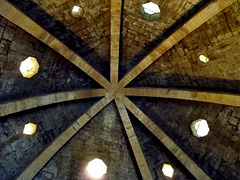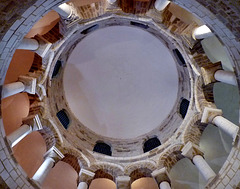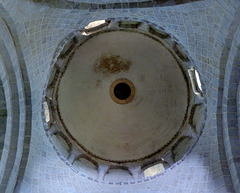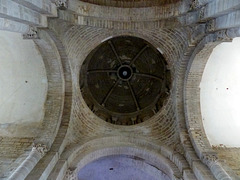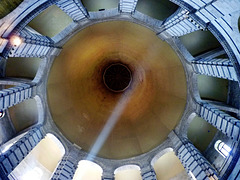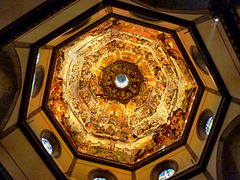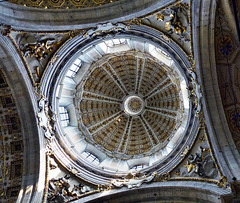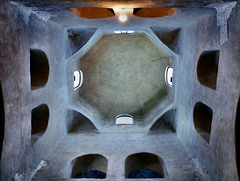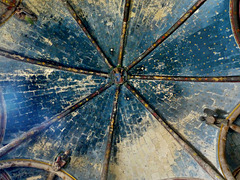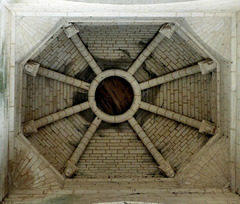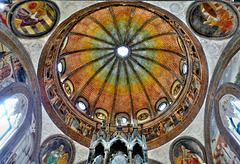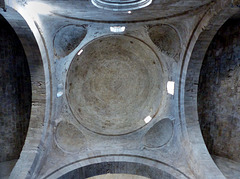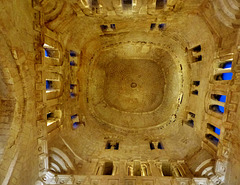
Domes
Saint Mary of Eunate
| |
|
|
Though, there is not much information about the origins of this wonderful, octogonal church, it has probably been an important place for the pilgrims since the 12th century, as from here to Puente la Reina, where the "Camino Aragonés" / "Via Tolosana" joins the busy "Camino Francés" is only a short walk. The church stands completely isolated, as it was not erected in or near a village, but in the middle of fields.
The floorplan of Saint Mary of Eunate is surely inspired by the "Church of the Holy Sepulchre of Jerusalem". Such churches (eg Tomar, Estrella, Pisa..) are often connected to the Knights Templar, but there no proof, that they have ever been in this area. The earliest documented reference is from 1487 and just mentions the "Virgin of Eunate", but at that time, the church was already centuries old.
The dome of Saint Mary of Eunate.
Neuvy-Saint-Sépulchre - Saint-Étienne
| |
|
|
This unique church complex, once part of a collegiate and dedicated to Saint-Jaques, combines a round church and attached to this a rectangular basilica.
A local noble named Eudes of Deols, who had traveled to the Holy Land in 1027, founded this church around 1040, a replica of the Church of the Holy Sepulchre at Jerusalem. Over centuries this was a major stop-over for pilgrims following the Via Lemovicensis.
Eleven pillars form the rotunda, that has a diameter of 8,30m. The number "11" may stand for the number of apostles after Judas left. The pillars have massive capitals.
Standing in the center of the rotunda - and staring up to the dome.
Saint-Aulais-la-Chapelle - Saint-Jacques
| |
|
|
Saint-Aulais-la-Chapelle, a village with a population of not even 300, hosts three Romanesque churches! One of these is Saint-Jaques in the tiny Hamlet of Conzac. Erected within the 12th century as a Cluniac priory church when pilgrims took a break here on their way to Santiago de Compostella. They still had about 1000 kms to walk from here.
The priory and the church got severely damaged during the Wars of Religions. The church, once built on the blueprint of a Latin Cross, lost one arm of the transept, the facade and a large part of the nave.
Though one arm of the transept does not exist anymore, the crossing survived with the dome and the four windows up there.
Saint-Amant-de-Boixe - Abbaye de Saint-Amant
| |
|
Legends tell, that Saint Amantius, born 520 in Bordeaux, lived a pious life here and did miracles. He died around 600 and his tomb was the center of the abbey founded here.
The monks followed the Benedictine rule from about 1000 on. Placed near the Via Turonensis a large church was needed. It got erected from 1125 on.
The church, seen here, got consecrated in November 1170. The abbey thrived and owned 16 priories alone. A blaze caused much damage to the convent in the 13th. century. Within the next century choir and cloister got rebuilt in Gothic style, but the 100 Years War stopped the development.
A decline started and in 1774 the last monk had left. As even the Maurists were not interested, the a royal edict ended the history of the abbey. After the French Revolution all convent buildings were sold. The church since then serves the parish.
Looking up to the dome over the crossing.
Pisa - Baptistry
| |
|
|
The construction of the "Battistero di San Giovanni" started in 1152 to replace an older baptistry. Since its completion in 1363 the transition from (Pisan) Romanesque to (Pisan) Gothic style was visible.
The baptistry was designed by Diotisalvi, who signed and dated the building ("1153"), similar to the "Chiesa del Santo Sepolcro" (previous uploads), he had designed some decades before.
The baptistry is about 54 m high, with a circumference of 107 m. Under the dome.
Florence - Cattedrale di Santa Maria del Fiore
| |
|
Florentina was established in Roman times as a settlement for veteran soldiers. The name had changed already, when young Charlemagne conquered the town in 774. It became part of the Duchy of Tuscany, with Lucca as capital. Around 1000 Margrave Hugo chose Florence as residency instead of Lucca. After the death of Matilda of Tuscany (1115), the Florentines formed a republic was ruled by a council. The town prospered, despite a constant fight between the different factions and noble families.
In the 15th century, Florence was among the largest and wealthiest cities in Europe. This was, when the Medici family entered the political scene. As a dynasty of art loving, power hungry bankers, they made Florence the birthplace of the Renaissance.
The construction of the cathedral, designed by Arnolfo di Cambio, started in 1296, replacing an older cathedral, that was too small for the growing population. It was completed about 140 years later with a dome engineered by Filippo Brunelleschi.
Looking up into the dome, that was largest dome in the world for a long time.
Como - Duomo di Como
| |
|
The "Cattedrale di Santa Maria Assunta" is often described as the last Gothic cathedral built in Italy. The construction started in 1396, on the site of the earlier Romanesque cathedral. Works did not finish until 1770 with the completion of the Rococo cupola. This dome over the transept, seen here, is 75 m high.
Galliano - Battistero di San Giovanni
| |
|
|
The Basilica di San Vincenzo and the Battistero di San Giovanni are on a hill in Galliano, just outside Cantù.
The church was consecrated in 1007, but that marks the end of a rebuilding process. This was sponsored by Ariberto da Intimiano, who was Bishop of Milano from 1018 on - and a strong supporter of Emperor Henry II and his successor Conrad II.
The large baptistery next to the basilica was probably erected at the same time. In the center of the "Battistero di San Giovanni" is a rectangular room, "created" by the four apses, seen from outside.
Standing in the center - looking up.
Over the eight windows of the upper matronaeum are the four windows of the dome. Additional light comes from a bulb.
Poitiers - Sainte-Radegonde
| |
|
|
Radegonde (aka "Radegund", "Radegundis") was a princess, born in Thuringia around 520. She was married to Chlothar I but left her husband and founded the convent "Sainte-Marie-Hors-les-Murs" in Poitiers around 552. The nunnery was the first and became the most important in the Frankish Empire. After having received a fragment of the "True Cross" from the Byzantine Emperor Justinian I, the name of the abbey changed to "Abbaye Sainte-Croix". In 587 Radegonde was buried here. The first church was erected over her tomb.
Radegonde´s remains were exhumed in 1012 for public veneration, what triggered a major pilgrimage to Poitiers. After a major fire, the church was rebuilt. The church of today, constructed from the 11th to 12th centuries, was built in a combination of Romanesque and Gothic styles.
The church is built in a "Latin Cross". Here is the dome over the crossing.
Roma - Pantheon
| |
|
The porticus of the circular Pantheon. The Pantheon (aka "La Rotonda") was a temple, completed around 114 aC, dedicated to all (pan) Gods (theon).
It is one of the best preserved antique structure and still the Pantheon's dome is the world's largest unreinforced concrete dome. The height to the "oculus" and the diameter of the interior circle are the same, 43.3 metres.
From 609 on the Pantheon was used as a church ("Sancta Maria ad Martyres"), today this is a major tourist attraction with more than 6 million visitors every year.
Since the Renaissance the Pantheon has been used as a tomb. Among those buried here is Raphael.
All tourists just have to take this shot, standing under the dome.
Parma - Battistero di San Giovanni
| |
|
|
Parma, part of the Holy Roman Empire since Charlemagne´s times, was locally ruled by its bishops. During the long Investiture Controversy, Parma was (mostly) member of the Imperial party ("Ghibellini"). Two of Parma´s bishops even became antipopes: Càdalo as Honorius II and Guibert as Clement III.
An almost independent commune was created around 1140. After the Peace of Constance confirmed the Italian communes' rights of self-governance in 1183, quarrels with the neighbouring communes (eg Piacenza and Cremona) developed over the trading lines along the Po river.
When in 1248 Papist families ("Guelphs") gained control over the city, Emperor Frederick II (aka "Stupor Mundi") besieged Parma with no success.
This were the circumstances, when in 1196 the City Council of Parma commissioned the building of the Battistero di San Giovanni to Benedetto Antelami. In 1216 the second tier was completed. The work stopped under a temporary roof. It continued in 1249 and the octagon, located next to the cathedral, was finally completed in 1270.
The interior of the baptistery contains sixteen arches, forming alcoves each containing a painted scene. All these are 13th and 14th century frescoes. Most striking is the painted domed ceiling. The dome is like an umbrella - sixteen rays come out of the center of the ceiling. Each corresponds to an arch below.
Bologna - Basilica del Sepolcro
| |
|
|
The Basilica del Sepolcro is part of the "Basilica di Santo Stefano" known as "Sette Chiese" (= "Seven Churches") that encompasses a complex of interconnected religious edifices, erected between the 5th and the 13th century.
Already within the 5th century Bishop Petronius built a "Holy Sepulchre" here, recalling the Church of the Holy Sepulche in Jerusalem, consecrated in 335.
Petronius´ church got severely damaged during the devastating invasions of Hungarian troops in the tenth century. The octogonal church got rebuilt a century later by Benedictian monks from red bricks. The dome above, seen here, is dodecagonal. It is supported by 12 columns.
Nieul-sur-l'Autise - Abbaye Royale Saint-Vincent
| |
|
|
The abbey was founded in 1068 by Ayraud Gadessenier, the Lord of Vouvant. Augustine Regulars lived here, responsible for cleansing the Poitevin swamps around.
Aénor de Châtellerault (1103 - 1130) is buried here. She was the mother of Eleanor of Aquitaine, who became tone of the most powerful women in medieval Europe. The status of the abbey was promoted to an "Abbaye Royale" in 1141 by King Louis VII, then husband of Eleanor of Aquitaine. Later, by her marriage to Henry II (Plantagenet), Eleanor was to become Queen of England.
The abbey was burnt down by the Huguenots in 1568 and went into decline. It got restored during the 19th century and still has a wonderful cloister.
Unfortunately my "timing" was quite bad that time. I reached at noon time - and was not patient enough to wait for some hours, as the cloister was locked for the lunchbreak. I´ll be back here later.
Looking up - the dome over the crossing.
Ygrande - Saint Martin
| |
|
Saint Martin´s preceding church belonged to the diocese of Clermont, but the Sires de Bourbon (-Archambaud) transferred it within the 11th century to the Bishop of Nevers. A century later it was owned by the Cluniac priory of Souvigny. At that time the old church got demolished and the erection of Saint Martin started.
Saint Martin is pretty large (35 meters long). The eastern parts of the structure (apse, crossing) are older than the nave and the aisles.
The crossing dome.
Milan - Galleria Vittorio Emanuele II
| |
|
|
Milan is the city capital of the Lombardy and the second most populous city in Italy after Rome. Known during Roman times as "Mediolanum" it was the place, where in 313 Constantine I and Licinius met and "signed" the "Edict of Milan", giving Christianity a legal status within the Roman empire.
At the end of the Roman empire Milan was besieged by the Visigoths in 402, looted by the Huns in 452, and taken by the Ostrogoths in 539. Only 30 years later is belonged to the Kingdom of the Lombards, until in 774 Charlemagne defeated the Langobards and added Milan to the Carolingian empire. During Barbarossa´s (Frederik I) "Italian Campaigns" Milan was taken and destroyed to a great extent.
Milan came back and flourished, when in 1386 the construction of the cathedral began. It took centuries to complete. In 1805, Napoleon Bonaparte, about to be crowned King of Italy here, ordered the façade to be finished in 1813.
The "Duomo di Milano" is surrounded by the "Piazza del Duomo". The most prominent building (next to the Duomo) is the "Galleria Vittorio Emanuele II" with its triumphal arch. It is the world´s oldest shopping mall, named after Victor Emmanuel II, the first king of the Kingdom of Italy, and built by Giuseppe Mengoni 1865 - 1877.
The structure consists of two glass-vaulted arcades intersecting in an octagonal space, that is topped with a glass dome.
Milan - Basilica di Sant'Eustorgio
| |
|
|
|
Milan is the city capital of the Lombardy and the second most populous city in Italy after Rome. Known during Roman times as "Mediolanum" it was the place, where in 313 Constantine I and Licinius met and "signed" the "Edict of Milan", giving Christianity a legal status within the Roman empire.
At the end of the Roman empire Milan was besieged by the Visigoths in 402, looted by the Huns in 452, and taken by the Ostrogoths in 539. Only 30 years later is belonged to the Kingdom of the Lombards, until in 774 Charlemagne defeated the Langobards and added Milan to the Carolingian empire. During Barbarossa´s (Frederik I) "Italian Campaigns" Milan was taken and destroyed to a great extent.
Only a few large structures survived the fury. One of them was the Basilica di San Lorenzo (see previous uploads). The Basilica di Sant'Eustorgio, located only about 500 ms south of the Basilica di San Lorenzo, existed already since centuries at that time, as it was founded in the 4th century. The name refers to Eustorgius I, the bishop of Milan (~350).
It is attributed to Eustorgius to have translated the relics of the Magi to the city from Constantinople in 344, a present of Roman Emperor Constantius II (337-361). This legend came up in the 12th century, when the "new" Basilica di Sant'Eustorgio was erected in Romanesque style.
When Milano was sacked by Frederick Barbarossa, Rainald von Dassel, who had just become Archbishop of Cologne and Archchancellor of Italy, entered the Basilica. In 1164 he brought the bones of the Magi with him to Cologne as loot from Milan and as a gift of Emperor Frederick Barbarossa. Since then the relics are in the Cologne Cathedral, where they are kept in the "Shrine of the Three Kings".
The Portinari Chapel is located behind the apse at the eastern end of the Basilica. It was commisioned by Pigello Portinari, who was the representative in Milan of the Medici bank. The chapel was completed in 1468. In the center the elaborate marble sepulchre of Saint Peter of Verona (aka "Peter of Mailand"), commissioned in 1336 from Giovanni di Balduccio, who signed his work.
"Divine light" flows from the multi coloured dome over the sepulchre.
Saint Peter of Verona (= "Peter of Mailand") was a Dominican friar and a celebrated preacher, who served as Inquisitor in Lombardy. He was was killed in 1252 by an assassin, and ("sancto subito") was canonized 11 months after his death. This was the fastest canonization in history. Carino of Balsamo, Saint Peter´s murderer, later repented his sin and became a Dominican lay brother. He is a "beatus" is known as "Carino Pietro da Balsamo".
Peter of Verona was a very popular saint. The "St. Peter von Mailand-Bruderschaft" in Cologne was founded as the brewers´ guild in 1386 - and it still exists.
Molfetta - Duomo di San Corrado
| |
|
Molfetta was probably been founded by the Greeks around the 4th century BC. Later it was Roman and after the fall of the Roman Empire, it was ruled by the Goths, who reinforced the city walls in the response of raids of Saracene pirates. The settlement developed under the alternate dominion of the Byzantines and Longobards. The Normans occupied Molfetta mid 11th century. Under the Norman rule, Molfetta became, just like Bari and Brindisi, an important starting point during the period of the crusades. Hospitals got erected to care for returning crusaders and hospices to host people heading to the "Holy Land".
-
The "Duomo di San Corrado" was erected between the second half of the 12th and the first half of the 13th century on a cliff overlooking the sea. First dedicated to Santa Maria Assunta, it is now dedicated to "San Corrado", patron saint of Molfetta.
San Conrado (aka "Conrad of Bavaria", "Konrad von Bayern") was a son of Henry the Black, Duke of Bavaria. Conrad was a disciple of Bernard of Clairvaux and a Cistercian monk. He journeyed to the "Holy Land" with the purpose of living there as a hermit but had to return. Returning to Apulia he stopped near Bari, where he lived as a hermit.
The Duomo is a very special example of Apulian Romanesque architecture, as it is the largest of the Romanesque churches with the central nave covered with three domes. The diameter of the largest dome is about 8 metres.
Monte Sant'Angelo - Tomba di Rotari
| |
|
|
Legends tell, that in 490, 492 and 493 the archangel Michael appeared to a shepherd and a bishop in front of a grotto. Archangel Michael instructing them to convert that cave into a Christian church. This grotto became the site of many pilgrimages since the early Middle Ages. It is said, that this is the oldest shrine in Western Europe
When the Lombards successfully conquered southern Italy end of the 6th century, King Grimoald in 662 passed on the region to his son, Romuald I, who renovated the sanctuary and encouraged its use as a pilgrimage site. It got very popular for pilgrims on their way to Jerusalem and as well for pilgrims who had followed the Via Francigena to Rome and then continued to the grotto. Many Popes have been here, but as well Bridget of Sweden, Bernard of Clairvaux, Thomas Aquinas, Matilda of Tuscany, Otto III...
Only about 100 meters south of the sanctuary is a complex of (once) three interconnected and partially nested buildings. The apse of the Church of San Pietro, the Church of Santa Maria Maggiore and the "Tomba di Rotari" (aka "San Giovanni Battista in Tomba").
It was believed, that this was the mausoleum of the Lombardian King Rothari, but that was a misinterpretation. The consent now, is, that the 12th structure was a baptistery, dedicated to John the Baptist.
The dome of the baptistery.
Jump to top
RSS feed- Latest items - Subscribe to the latest items added to this album
- ipernity © 2007-2024
- Help & Contact
|
Club news
|
About ipernity
|
History |
ipernity Club & Prices |
Guide of good conduct
Donate | Group guidelines | Privacy policy | Terms of use | Statutes | In memoria -
Facebook
Twitter

